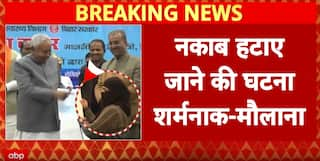Onam 2022: Know All The Mythological Stories Around The Festival Of Onam
The festival of Onam has already started and the last day of Onam, called 'Thiruvonam' will be celebrated this Thursday. Here are all the mythological stories around Onam, that you should know!

New Delhi: Onam is traditionally celebrated for 10 days beginning on the first day of the Malayalam month of Chingam. The rice harvest festival is majorly observed in Kerala. In popular mythology, Onam symbolises King Mahabali's (or Maveli’s) yearly journey from the underworld, where he was thrown by Lord Vishnu, to see his adored subjects on earth.
The Story Of Onam: Vamana And King Mahabali (Maveli):
The Bhagavata Purana, which recounts one version of the tale, claims that the asuras, commanded by King Mahabali, expelled the devas from the skies and then conquered the three worlds. In order to solidify his power, Bali, the asura king, then began to perform an Ashwamedha Yagna, or a horse sacrifice. Aditi, Indra's mother, pleaded to Vishnu in the meantime because she was miserable with the thought that her son had been defeated by Mahabali. In response to her cries, Vishnu emerged from her womb to assist her son Indra in regaining control of the sky. Taking the form of a dwarf brahmin, Vishnu arrived at the horse sacrifice, where Mahabali was making generous donations to all the needy Brahmins.
According to legend, the small Vamana requested three-foot-long pieces of land from the monarch. Mahabali chose to fulfill the Brahmin's demands despite being forewarned by his mentor Shukracharya that the dwarf was none other than Lord Vishnu. Vamana the dwarf is claimed to have grown into a giant of cosmic proportions after Mahabali promised to give him three paces of land, and after taking two enormous steps to measure the globe and the heavens, he is reported to have asked Mahabali where he might keep his final step.
The vanquished Mahabali submitted by giving the deity his own head because there was no longer any space in the universe for Vishnu to use as his third pace of land. From this point on, the narrative varies slightly throughout the numerous variations. One account has Vishnu pushing Mahabali into the netherworld while keeping his foot on his head and commanding him to control it from there. In another version, Vishnu asks him to live there and control it instead of pushing him into the underworld and assures him that he will become Indra in another yuga.
The Bhagavat Purana says that Mahabali was punished despite being a victorious king because his humility had been damaged by corruption brought on by authority and the pursuit of material gain. He even disregarded his guru's advice to give the Brahmin dwarf the present he requested, despite the fact that he was well aware the Vamana was none other than Lord Vishnu, because of his arrogance.
Surprisingly, not all textual versions refer to Bali's request to annually visit his home and his favourite subjects. The part about Mahabali returning to earth every year seems more like a folk interpretation of a Puranic tale. The festival of Onam, which commemorates Bali's return to the ground, is mainly based on the folk celebration celebrating the end of the paddy harvest.
Why Was King Mahabali Punished?
The Malayalam folk songs are performed to welcome King Mahabali on this occasion to honour his just and egalitarian rule. Other folk motifs include the use of pyramid-shaped four-sided clay blocks called Onathappan that are used to symbolically depict a local God known as Thrikkakara appan or Vamana Vishnu. The other folk practices of the festival consist of sports and cultural activities like the kathakali, and the renowned boat race.
It's interesting that Kerala is not the only place where Bali is celebrated. The fourth day of Diwali, which signifies the conclusion of the summer harvest, is known as Balipadyami or Balipratipada and is a time when many regions of western and southern India honour and commemorate King Bali. In reality, Maharashtrian farmers pray yearly for King Bali's fair and just rule to return.
The Mythological Connection Between Lord Parashurama And Onam:
In modern narratives, the mass popularity of the legendary Asura king punished rather unduly by Vamana Vishnu, has led the story to be interpreted as a conflict between two different cultures, where an Aryan tribe, represented by their god, established supremacy over Bali, the just and fair king of a non-Aryan tribe. This version is in sync with other subaltern narratives where the Asuras have been understood to be the oppressed class with the Devas being envisioned as the upper caste oppressors. Moreover, the Vamana story also comes across as a sort of a prequel to the story of Parashurama, another avatar of Vishnu, who, despite being a Brahmin, took to arms to end the tyranny of the Kshatriyas or the ruling class.
The Vamana story appears to be a type of prologue to the tale of Parashurama, another Vishnu avatar who, despite being a Brahmin, took up arms to overthrow the Kshatriyas, or ruling class, in order to save the world. The entire western coast of India is thought to have been reclaimed from the sea by Parashurama with his axe in order to rehome the Brahmin population, according to a legend that connects both of these tales. Additionally, Onam commemorates the sage's establishment of Kerala.
In her book, Book of Vishnu, author Nandita Krishnan offers a radically different version of the myth. According to the author, the Rigveda and the Shatapatha Brahmana, literature used in Vedic rituals, are the origins of the Vamana avatar myth. These scriptures listed Vishnu as one of the 12 adityas, or solar deities, and thought him to be an aspect of the Sun. Throughout the course of the day, the sun moves in three straight lines across the sky: at sunrise, at midday, and at sunset, when it sinks below the horizon.
The earth, the heavens, and the underworld are all covered in three steps by Vishnu when he assumes the Vamana avatar. After a scorching summer as pictured by the solar deity Vishnu, Nandita says that the Onam celebration is a symbolic portrayal of the harvest, which is welcomed with a thanksgiving sacrifice called "Bali." Onam thus symbolises the harvest festival that was made possible by the Sun, to whom Mahabali or a huge offering is offered, just like Pongal or Baisakhi.






































